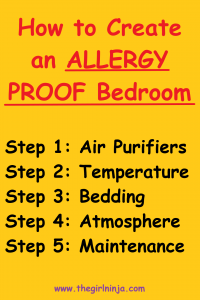Do you suffer from seasonal and/or dust allergies making you groggy, and unable to wake up in the morning feeling refreshed?

I did for years. Like many, my dust allergy flared up as I slept and by morning I was so congested I had trouble waking up. When I finally dragged my body out of bed I still felt stuffy and exhausted. On my worst days the exhaustion never yielded, no matter how much caffeine I consumed. I would try going for walks and listening to music, nothing worked, my eyelids did not want to stay open, and all I could think of was finding someplace to lay down.
It feels like no matter what you do there is no allergy relief or any allergy remedies strong enough to help you.
If you struggle to find allergy relief or allergy remedies you are not alone. There should be more support groups for individuals with allergies. One in every town.
It took me years to figure out that my bedroom was a breeding ground for dust mites to a point that it was taking over my life. Once I realized that bedroom dust was the cause of my constant drowsiness my family and I decided we needed to fix it. That is what we did, we came together and made my bedroom allergy friendly, now my bedroom is a haven where I feel clear of allergies and wake up feeling refreshed.
Here I describe what I use in my bedroom and what we do to make the bedroom allergy friendly. Obviously everyone’s allergies are unique to them, so I am not sure what your exact needs are, but I hope my description below helps us all better understand how to allergy proof your home and specifically create an allergy proof bedroom. Below I describe the exact changes you can make to create an allergy proof bedroom in 6 easy steps.
Step 1: Get a husband
Just kidding, lol. My husband helped a lot with all of the changes we had to make so I encourage you to ask your significant other or a friend for help, but obviously you can make these changes independently too.
Step 1: Allergy Proof Bedrooms Have An Air Purifier
Research air purifiers and select the one that makes sense for your needs. I am allergic to dust so I wanted to be sure the purifier I selected worked for dust. Another huge factor of the purifier you choose is budget. Air purifiers can vary from $30 to $1000+. The price typically speaks to the square footage the purifier will work for as well as the diversity of particles the purifier will work at removing from the air. The cost of an air purifier may also correlate with how quiet or loud the air purifier is. Below is the air purifier we selected for an allergy proof bedroom.

Once you have an air purifier, the location you place the air purifier is key to whether or not it will provide allergy relief or truly create an allergy proof bedroom. Here are the key conditions for where to place an air purifier in your bedroom.
First of all ensure that the air purifier is placed in a location clear of clutter. You will want the air to be able to freely flow into the back of your air purifier and freely flow out the front of your air purifier.
Secondly, height is also important for your air purifier. If you have an air purifier sitting on the floor, expect it to circulate everything underneath your bed as well as underneath any other furniture in your bedroom. It is optimal to place your air purifier at a height at or above the middle height of your bedroom. If you have a tall dresser and a short wide dresser it is more optimal to place the air purifier on the short wide dresser. This allows it to replace the air flowing over your bed, that you are breathing in as you sleep.
We specifically face the air purifier so that it blows air directly over the side of the bed that I sleep on. How close you want it to you is dependent on your specific comfort. Obviously it would be best if it was a foot or two away from our faces constantly blowing clean air at us, but I personally find that very uncomfortable. So, we place the air purifier about 3 feet away from the foot of our bed on top of a dresser, and that does the trick.
Another key factor in ensuring your air purifier is working optimally for you is when you turn it on and off. How often your air purifier is on will be dependent on how frequently you are in your bedroom as well as how severe your allergies are. For a situation where you are only in your bedroom for the most part at only night time the following pattern of air purifier use makes the most sense.

A half hour to an hour before you get into bed you will want to turn your air purifier on. This allows the air purifier to displace any allergens that have settled on you bed or pillow before you get into bed. Then it is best to leave the air purifier on for the continuation of the time you are in bed. When you wake up in the morning, if you allergies allow it, it is best to turn your air purifier off.
You might ask, why would I ever turn the air purifier off?
Great question, ideally we would have the air purifier on at all times. However for myself and others out there watching their budget, air purifiers have filters that need to be replaced after a certain number of hours used. Air purifiers also use a decent amount of electricity, it’s comparable to having a fan plugged in and running. So, to save yourself 12+ hours of electricity use and filter expenses, as well as to save on the life of your air purifier turn it off when you wake up or before you leave your bedroom for the day.
Should you get a travel air purifier?
In addition to the air purifier for the bedroom, we also purchased a smaller air purifier for travel. I travel periodically for work as well as out of state regularly to visit family. So this air purifier seemed well worth it to me. The air purifier we selected for travel is small and does not cover much square footage, but if you place it right next to the bed you are sleeping in I find it works great. Of course, this means it is blowing in my face, but it’s tolerable for intermittent use. Above you can find the small air purifier you can travel with to create an allergy proof bedroom on the go, next to the at home air purifier we have.
Step 2) Temperature Control Your Bedroom
Dust mites thrive at temperatures between 68-77°F. So if you keep the bedroom at a cool 65°F it will significantly help reduce the number of dust mites that decide to chill in your bedroom. To be honest I’m always a little chilly at 65°F, especially in the winter, but I still prefer to be cold than wake up stuffy and exhausted.
Step 3) Allergy Proof Bedrooms Have Hypoallergenic Bedding
(Pillows, Sheets, and Blankets)
Burying your face every night for hours into a fabric that is ideal for allergens to hang out in, make any allergy control far fetched. Be sure to research different hypoallergenic fabrics to select fabrics that make the most sense for your allergies. You should ensure you have hypoallergenic pillows, sheets, and a hypoallergenic comforter. Be sure to eliminate any bedding that isn’t necessary, excess fabric in a room is just another space for allergens to live in and reproduce. Below are links to the hypoallergenic bedding we selected for our bedroom.
Allergy Proof Tips
No throw pillows, unless they are allergy friendly of course. Still though, try to avoid extras.
When selecting hypoallergenic materials, specifically for a dust allergy, know that bamboo is not the way to go. Although, bamboo is hypoallergenic for some allergens it is NOT hypoallergenic for dust mites.
Choose to NOT have plants in your bedroom. Plants are living organisms that give signals to other organisms that it is a great location to hangout. Dust mites are an organism, so reduce living organisms in your room to keep dust at bay, and enjoy your plants elsewhere.
Step 4) Clean-Out Your Bedroom to Keep it Allergy Proof
The more stuff in your room the more surfaces allergens have to live on, so to have an allergy proof bedroom think minimalist. Have as few decorations as possible, wall and shelf decorations/ knick-knacks should be moved to other rooms. Make sure all clothing and fabric are stored in enclosed containers that can be easily wiped down, closets, dressers, etc. In particular you will want to avoid hooks in your bedroom to hang towels or jackets or scarves. I hide my hooks for scarves and other items on the inside of my closet door. Also avoid upholstered furniture, dust mites love fabric furniture.
Step 5) Maintain Cleanliness in Your Bedroom to Keep it Allergy Proof

Now that you have a space designated for you, the only thing left to do is maintain the space. To keep allergens at bay in your hypoallergenic bedroom plan a maintenance cleaning schedule that includes vacuuming/sweeping your floor, wiping down window and door frames, as well as wiping down furniture, and washing bedding. Don’t forget to dust/wipe down any other items in your room like a television, knick-knacks, or picture frames. The frequency of this room clean will vary from person to person depending on availability to clean, and severity of allergies. We wipe down our bedroom every other month, and try to wash bedding every 2 weeks.
While maintaining your allergy friendly space be sure to plan to replace the filter in your air purifier if needed, as advised by the manufacturer.
Allergies are a beast that can really ruin our day. It’s up to us to try to control our environments to reduce our symptoms. Please add to the comments what you find most helpful for your allergies.
